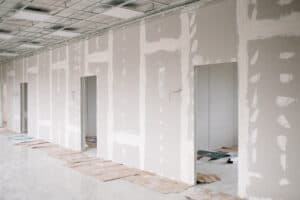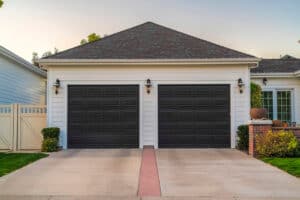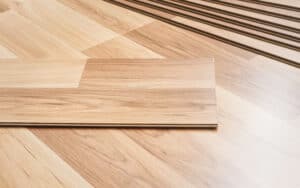
When it comes to flooring, one of the most expensive types is hardwood.
Loved for its timeless appearance and rich color and texture, hardwood floors are common in highly-valued homes.
If you’re thinking of installing hardwood floors in your home, you’ll likely notice how expensive it is to buy hardwood floors.
Considering it’s just made out of wood, you may wonder why hardwood floors are so expensive.
Why Is Hardwood Flooring So Expensive? (10 Reasons)

The average price of hardwood flooring costs from $6 to $18 per square foot, but it can also reach as high as $24 per square foot.
Hardwood flooring is expensive because of the reduced supply of wood, labor costs, and the high costs of producing hardwood flooring in the United States.
Let’s look at these factors in more detail.
1. Reduced Hardwood Supplies

The best hardwood floors come from actual hardwood.
The problem with hardwood is that there’s significantly less hardwood today than there was a few decades ago.
Part of that is because sawmills cut down trees without worrying about supply.
They didn’t think about conservation.
Even if they had re-planted trees as they cut, it can take a long time for hardwood trees to reach the right size for cutting.
Another problem is that hardwood trees aren’t suitable for branch-cutting like softwood trees.
The advantage of softwood trees is that you can cut the branches and still use the wood to make products.
With hardwood trees, the technology available doesn’t make it as easy or fruitful.
A lack of hardwood trees means that the supply available to make hardwood flooring is small.
However, demand for hardwood flooring remains high.
Homeowners and businesses want the stately and beautiful appearance that hardwood floors offer.
With low supply and high demand, the price of hardwood flooring increases.
Hardwood flooring is expensive because there is a reduced supply of hardwood trees available for cutting.
2. Lack Of Large Trees Due To Over-Cutting

Part of the reason hardwood wood isn’t in abundant supply anymore is that most of the large trees in the United States are gone.
Back in the day, sawmills could easily produce a ton of hardwood planks because there were huge trees around.
A single tree could provide a ton of wood.
It allowed there to be a steady supply of hardwood planks.
That isn’t the case anymore.
Since the sawmills of old cut down most of the large trees, only the younger ones are still around.
Because they’re younger and thus smaller, they don’t produce as many hardwood planks as the larger ones did.
It takes more hardwood trees to produce the same number of hardwood planks as a single, large, hardwood tree would offer.
This isn’t a problem that is easily fixed either.
In order to reach the same width and height as the old, large trees, woodcutters would have to plant and leave the hardwood trees alone for decades if not centuries.
Few companies are that forward-thinking.
Because they can’t produce as many planks as they used to, the price of hardwood flooring has increased.
Hardwood flooring is expensive because there are few if any large hardwood trees left.
3. Moisture Barrier And Adhesive Costs

Hardwood flooring installation isn’t as easy as just putting the planks down and hammering them in place.
There are a few steps involved.
One of the most important steps is putting in a moisture barrier called an underlayment.
Not every hardwood floor will have an underlayment, but most professionals will suggest having one.
An underlayment is important because it provides quite a few benefits.
For one, it can protect your hardwood floors from moisture.
Wood and moisture do not get along well.
Even treated wood can start to deteriorate if you’re not sealing it regularly.
The last thing you want to see is mold growing on your hardwood floors.
The underlayment can help protect it.
It can also help ensure water and other liquids don’t seep through the hardwood floors to the foundation below.
Another benefit of an underlayment is its ability to reduce sound.
Hardwood flooring can be quite loud to walk on.
To reduce that noise, some types of underlayment provide a cushion.
That softens the noise.
Installing an underlayment costs more money, especially if you choose a more expensive underlayment type.
There are four main types of underlayment materials.
Those types include:
- Felt
- Foam
- Cork
- Rubber
If you choose a high-quality version, especially felt, you can expect a high price.
Hardwood flooring is expensive because of the cost that the underlayment adds to the service.
4. Lengthy Installation Process

Installing hardwood flooring takes time.
There are several steps involved.
To install hardwood flooring, you need to install the subfloor first.
Then you need to take care of the underlayment and anything else that goes between the two floors.
Finally, you can start laying down the planks.
The job doesn’t end there either.
Usually, hardwood flooring installers will sand the floor and buff it.
Some will stain it or let you stain it.
Once they finish the installation, the clean-up process is just as lengthy.
Installing hardwood flooring is a messy job.
Because of the length of time that it takes, you can expect some pretty high labor costs.
The job isn’t something automated.
It takes real workers and human workers need breaks.
Depending on the size of the room or how many floors you want to be installed, the job could take a few days.
All the while, you have to pay them for their time.
Since some companies charge by the hour, you’ll find that hardwood flooring installation can be very expensive.
Hardwood flooring is expensive because the installation process can take a long time which drives up labor costs.
5. Sanding Process

One of the most important steps in installing hardwood flooring is the sanding process.
When hardwood planks come to your door, they’re typically not sanded.
They’re rough planks.
Hardwood flooring contractors will lay those planks down, sand them once they’re set.
The sanding process is expensive since it requires them to use a sander.
If you’re installing hardwood flooring on your own, you’re going to need to rent a sander at your local hardware store.
Sanders can be quite expensive since they do a very specific job and do it well.
You essentially run it across the planks and the sander smooths out the rough edges.
The problem with hardwood flooring is that you have to sand them regularly.
Every few years, it’s a good idea to re-sand your floors.
That’s because time and use can roughen them up again.
It’s a service that you’re going to need to keep hiring or renting equipment to do yourself.
That makes owning hardwood flooring a bit expensive.
It isn’t just the initial sanding and installation that you have to pay for.
You also have to continue to sand your floors every few years.
Hardwood flooring is expensive because the sanding process can be expensive.
6. Buffing And Staining Costs

Besides sanding, another regular service you’ll need to keep your hardwood flooring looking its best is buffing and staining services.
When hardwood floors are initially put down, the company will buff and stain the floors for you.
You’re usually able to choose the stain that you want, they’ll paint it for you.
As with other types of wooden products, the shiny surface and color fade with time.
The more that people use your hardwood floors, the faster they lose their shine and color.
As such, much like sanding, you’re going to find yourself needing additional buffing and staining services.
Buffing can ensure your floors stay as shiny as they should be.
Staining ensures that your floors continue to showcase a deep, rich color.
Some stains also provide certain protections like scuff protection or stain protection.
Re-staining the floor can further ensure they’re kept safe.
Both services can be expensive, however.
If you’re hiring contractors to perform them, you can expect pricey labor costs.
If you want to do it yourself, you’re going to need to buy or rent the equipment and buy the stain.
Either way, you’re looking at expensive prices to keep your floors looking great.
Hardwood flooring is expensive because the costs of buffing and staining your hardwood floors can be expensive.
7. Installation Done By Hand

Another big factor that makes hardwood flooring expensive is that it’s all done by hand.
In some cases, workers can rely on tools or machines to speed up the process.
That isn’t the case when it comes to installing hardwood flooring.
Instead, everything is essentially done by hand.
From the laying of the floor to the final staining process, the workers are on their hands and knees installing the floor.
It’s labor-intensive with most of the work coming from the workers themselves.
Besides labor, you’re also paying for their experience.
The more experience a contractor has, the more expensive they are.
That’s because you’re essentially paying for a high-quality service.
You’ll receive fewer problems and come out with an incredible floor as a result.
Hardwood flooring is expensive because it’s a labor-intensive process that is costly.
8. Wildfires Impacting Wood Supply

One of the problems with hardwood flooring is that the price of wood can make up a large portion of the initial cost.
Even if the installation services were cheap, the price of wood makes hardwood flooring quite expensive.
One of the reasons the price of wood is high is due to wildfires.
To make hardwood floors, you need hardwood.
Hardwood is already in short supply due to previous clearings.
The hardwood that remains is under threat by wildfires.
In California, in particular, wildfires have destroyed acres of hardwood trees.
Those trees could have become hardwood floors, but the fire destroyed them before the sawmills could cut them down.
Since it takes a long time for trees to grow, wildfires impact the supply of hardwood available.
Hardwood flooring is expensive because wildfires are reducing the supply of hardwood.
9. Ash Bore Beetle Killing Ash Trees

Another problem impacting the supply of hardwood is the ash bore beetle.
The ash bore beetle is an invasive beetle that is responsible for destroying tons of ash trees.
Ash is a common type of hardwood used for hardwood flooring.
Since there hasn’t been a way to stop the spread of the invasive species, ash trees have fallen in population.
That impacts how much hardwood becomes available because sawmills still have to be mindful of how much wood they’re cutting in the first place.
If beetles are ruining the supply of trees, sawmills have even fewer trees that they can cut down.
Hardwood flooring is expensive because of the reduced supply of ash trees due to the ash bore beetle.
10. USA-Made Hardwood Flooring Planks

A final reason hardwood flooring is expensive is that it a lot of hardwood floors come from the United States.
Companies will source the wood from the United States using US-based workers.
Workers in the US tend to be expensive since the cost of living is higher in the United States.
Then the wood will go to a mill where it will become planks.
The workers in the mill are also in the United States and receive high wages.
Finally, the installation process involves the use of US workers.
Their wages are high as well.
Anything made in the United States tends to be more expensive because the costs are higher.
Hardwood flooring is expensive because it usually comes from the United States.



Leave a Reply